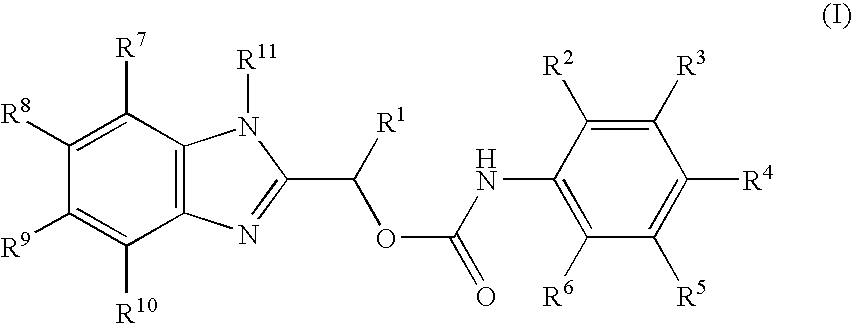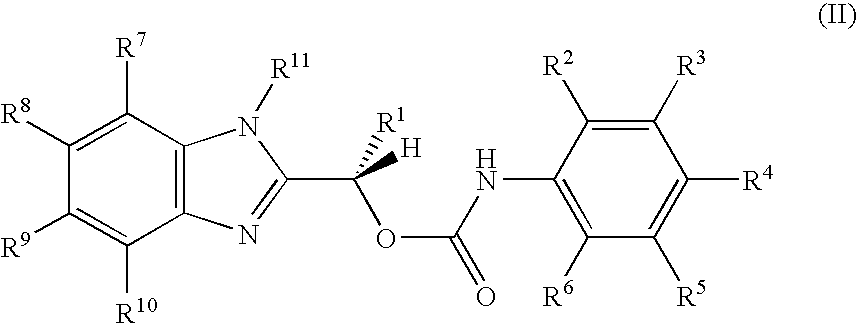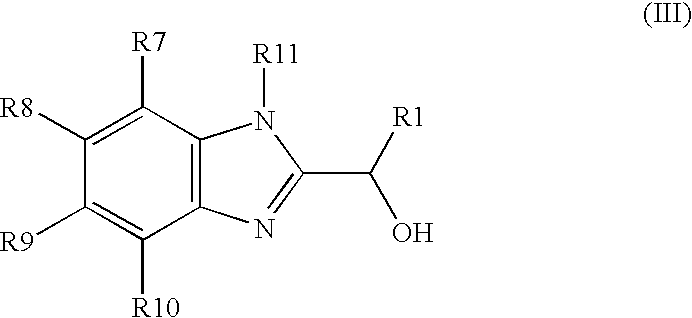Carbamate compositions and methods fo rmodulating the activity of the CHK1 enzyme
a technology of rmodulating activity and carbamate, which is applied in the field of carbamate compositions and methods of rmodulating the activity of the chk1 enzyme, can solve the problems of limiting the amount, numerous unwanted side-effects or adverse reactions, and delay in the cell cycle during which important cellular events occur, so as to enhance the effect of dna-damaging agents, facilitate preparation and detection, and enhance the effect of
- Summary
- Abstract
- Description
- Claims
- Application Information
AI Technical Summary
Benefits of technology
Problems solved by technology
Method used
Image
Examples
example 1
[0292] Preparation of Compound (41)
[0293] 1,2-dichloro-4-isocyanatobenzene (0.38 g, 2.0 mmol) was added to a solution of 1H-benzimidazol-2-ylmethanol (0.30 g, 2.0 mmol) in 7 ml of DMF. The reaction mixture was stirred at 80° C. for 1 hour. Extraction using EtOAc followed by re-crystallization in EtOAc yielded the title compound (0.52 g) in 78% yield.
[0294]1H-NMR (d6-DMSO): δ 12.61 (s, 1H), 10.28 (s, 1H), 7.84 (d, 1H, J=2.4 Hz), 7.70-7.50 (broad, 2H), 7.60 (d, 1H, J=8.8 Hz), 7.47 (dd, 1H, J1=8.8 Hz, J2=2.4 Hz), 7.30-7.15 (m, 2H), 5.39 (s, 2H).
example 2
[0295] Preparation of Compound (39)
[0296] Preparation of Compound (39) from 1,2-difluoro-4-isocyanatobenzene (0.23 g, 1.5 mmol) and 1-(1H-benzimidazol-2-yl)ethanol (0.24 g, 1.5 mmol) was carried out analogously to the preparation described in Example 1. Silica gel chromatography (dichloromethane / methanol 100 / 4) afforded the title compound (0.10 g) in 21% yield.
[0297]1H-NMR (d6-DMSO): δ 12.50 (s, 1H), 10.08 (s, 1H), 7.70-7.10 (m, 7H), 6.10 (q, 1H, J=6.7 Hz), 1.71 (d, 3H, J=6.7 Hz).
example 3
[0298] Preparation of Compound (10)
[0299] Preparation of Compound (10) from 2-chloro-1-fluoro-4-isocyanatobenzene (0.21 g, 1.3 mmol) and 1-(1H-benzimidazol-2-yl)ethanol (0.21 g, 1.2 mmol) was carried out analogously to the preparation described in Example 1. Silica gel chromatography (dichloromethane / methanol 10 / 2) afforded the title compound (60 mg) in 14% yield.
[0300]1H-NMR (d6-DMSO): δ 12.50 (s, 1H), 10.08 (s, 1H), 7.78-7.67 (m, 1H), 7.54 (m, 2H), 7.45-7.27 (m, 2H), 7.25-7.10 (m, 2H), 6.00 (q, 1H, J=6.7 Hz), 1.72 (d, 3H, J=6.7 Hz).
PUM
| Property | Measurement | Unit |
|---|---|---|
| Electrical conductance | aaaaa | aaaaa |
| Composition | aaaaa | aaaaa |
| Structure | aaaaa | aaaaa |
Abstract
Description
Claims
Application Information
 Login to View More
Login to View More - R&D
- Intellectual Property
- Life Sciences
- Materials
- Tech Scout
- Unparalleled Data Quality
- Higher Quality Content
- 60% Fewer Hallucinations
Browse by: Latest US Patents, China's latest patents, Technical Efficacy Thesaurus, Application Domain, Technology Topic, Popular Technical Reports.
© 2025 PatSnap. All rights reserved.Legal|Privacy policy|Modern Slavery Act Transparency Statement|Sitemap|About US| Contact US: help@patsnap.com



